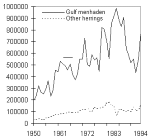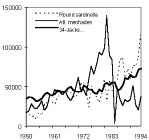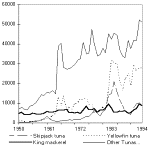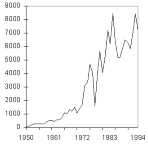FAO Fisheries Circular No. 920 FIRM/C920
Rome, 1997
ISSN 0429-9329
REVIEW OF THE STATE OF WORLD FISHERY RESOURCES: MARINE FISHERIES
by
Marine Resources Service,
Fishery Resources Division,
Fisheries Department,
FAO, Rome, Italy
3. WESTERN CENTRAL ATLANTIC
FAO Statistical Area 31
INTRODUCTION

The waters incorporated in Area 31 (Figure B3.1), the Western Central Atlantic, centered on the Caribbean and Central American States, include a diverse array of fisheries and harvested fish species. The FAO FISHSTAT system has records of 147 species or species groups being caught in these waters between 1950 and 1994. The species groups reported include categories such as "marine molluscs: not identified" and "finfishes: not identified", so the actual number of species harvested is likely to be much higher. A total of 26 states from the area have recorded landings on the system and many of these would include fisheries ranging from artisanal to commercial operations within their national fisheries. The oceanography of the region is heavily influenced by the runoff of the major river systems of the Mississippi, Orinoco and Amazon rivers. These river systems, demonstrating mesoscale variability in runoff, contribute to inter-annual variability within the marine system which is also influenced by other climatic factors, including hurricanes .
The fisheries of the region have been characterized by generally increasing catches in recent decades as fishing pressure has risen. However, knowledge of the status of the stocks being harvested is generally poor, and sustainable levels of fishing mortality are essentially unknown for most species. There is a common belief that many stocks are being fully or over-exploited and there is concern for the status of species such as Nassau grouper Epinephelus striatus and jewfish E. itajara, the spiny lobster in some regions, and the queen conch. The greatest need in the region is for improved knowledge of the status and potential productivity of the stocks and of the fisheries harvesting them, to enable implementing appropriate management action.
PROFILE OF CATCHES
Figure B3.2
 The total fish landings from the area have increased fairly steadily since
1950, reaching a peak at over 2.5 million tonnes in l984 before falling until
1992, followed by a recovery in 1993 and 1994. In 1994 they stood at over
2.1 million tonnes, compared to an average of less than 1.5 million tonnes
between 1950 and 1994 (see Figure B3.2 and Table
III).
The total fish landings from the area have increased fairly steadily since
1950, reaching a peak at over 2.5 million tonnes in l984 before falling until
1992, followed by a recovery in 1993 and 1994. In 1994 they stood at over
2.1 million tonnes, compared to an average of less than 1.5 million tonnes
between 1950 and 1994 (see Figure B3.2 and Table
III).
| Figure B3.3 | Figure B3.4 |

 The single major contributor to the landings at the ISSCAAP Group level are
the pelagics of Group 35 (herrings, sardines and anchovies, etc.). Of these,
ranking first and third respectively in terms of 1994 landings were the Gulf
menhaden and the Atlantic menhaden. The landings of these two species
in 1994 were 767 000 t and 37 500 t respectively, the former showing some recovery
after the decline in landings in the late 1980s and early 1990s, while those
of the latter remained substantially lower than the peak of the early 1980s.
Combined, they represented 80% of the landings of pelagic species in ISSCAAP
groups 34 and 35, and 38% of total landings from the region. There has also
been a generally increasing trend in landings of small pelagics since the early
1970s (Figures B3.3 and B3.4).
The small pelagics from Group 35 providing the largest landings, apart from
those of menhaden, are largely clupeoids, particularly round sardinella and
Atlantic thread herring. Within Group 34, the unidentified mullets and the Flathead
gray mullet yielded the greatest landings in 1994 followed by the Caranx
species (Table III).
The single major contributor to the landings at the ISSCAAP Group level are
the pelagics of Group 35 (herrings, sardines and anchovies, etc.). Of these,
ranking first and third respectively in terms of 1994 landings were the Gulf
menhaden and the Atlantic menhaden. The landings of these two species
in 1994 were 767 000 t and 37 500 t respectively, the former showing some recovery
after the decline in landings in the late 1980s and early 1990s, while those
of the latter remained substantially lower than the peak of the early 1980s.
Combined, they represented 80% of the landings of pelagic species in ISSCAAP
groups 34 and 35, and 38% of total landings from the region. There has also
been a generally increasing trend in landings of small pelagics since the early
1970s (Figures B3.3 and B3.4).
The small pelagics from Group 35 providing the largest landings, apart from
those of menhaden, are largely clupeoids, particularly round sardinella and
Atlantic thread herring. Within Group 34, the unidentified mullets and the Flathead
gray mullet yielded the greatest landings in 1994 followed by the Caranx
species (Table III).
Figure B3.5
 In 1994 the largest landings of large pelagics in ISSCAAP Group 36 (tunas,
bonitos, billfishes etc.) came from yellowfin tuna (28 000 t), Atlantic Spanish
mackerel and king mackerel (19 000 t and 9 000 t respectively) and skipjack
tuna (8 000 t). Landings of ISSCAAP Group 36 species have shown substantial
increases over the period 1950 to 1994 (Figure B3.5).
In 1994 the largest landings of large pelagics in ISSCAAP Group 36 (tunas,
bonitos, billfishes etc.) came from yellowfin tuna (28 000 t), Atlantic Spanish
mackerel and king mackerel (19 000 t and 9 000 t respectively) and skipjack
tuna (8 000 t). Landings of ISSCAAP Group 36 species have shown substantial
increases over the period 1950 to 1994 (Figure B3.5).
Contributing substantially less than the small pelagics in terms of landed weight, but certainly of considerable total economic value, are ISSCAAP Group 45 (shrimps, prawns etc.), Group 33 (redfishes, basses, congers etc.), and the other higher value species groups. A cause for concern is the substantial increase in ISSCAAP Group 39 (miscellaneous marine fishes) (Figure B3.2). This group accounted for approximately 40% of total finfish landings in 1994, excluding menhaden. Without accurate data on the species composition of landings, and associated information on effort, it is impossible to assess the status of the stocks, and better identification of fish landings should be given a high priority by those countries in the region which are failing in this regard.
The fisheries for crustaceans in this area are dominated by those for the Caribbean spiny lobster and penaeid shrimps, the latter particularly from the Gulf of Mexico and the Guianas-Brazil subregion. Landings of the spiny lobster have increased fairly consistently since 1950 (Figure B3.6) while the total annual shrimp catch from the region has fluctuated around approximately 170 000 t for two decades The production of shrimps and prawns by aquaculture has grown substantially in recent years, reaching over 11 000 t in 1994 or 7% of the total shrimp production, including aquaculture, from the region (Figure B3.6).
Figure B3.7
 Several mollusc species support valuable fisheries in the area, in particular
the fisheries in the USA for cupped oysters and calico scallops. In 1994,
recorded landings for these species were 59 000 t and 74 000 t respectively,
the latter showing recovery after the dramatic decline of the early 1990s.
Production of cupped oysters was supplemented by the culture of nearly 90
000 t of the species in Mexico and the USA in that year. Landings of queen
conch have increased substantially over the last 25 years but declined somewhat
after a peak at nearly 8 000 t in 1984 ( Figure B3.7).
In 1993 landings again rose above 8000 t, but declined to just more than 7
000 t in 1994. The status of the stock is currently causing concern.
Several mollusc species support valuable fisheries in the area, in particular
the fisheries in the USA for cupped oysters and calico scallops. In 1994,
recorded landings for these species were 59 000 t and 74 000 t respectively,
the latter showing recovery after the dramatic decline of the early 1990s.
Production of cupped oysters was supplemented by the culture of nearly 90
000 t of the species in Mexico and the USA in that year. Landings of queen
conch have increased substantially over the last 25 years but declined somewhat
after a peak at nearly 8 000 t in 1984 ( Figure B3.7).
In 1993 landings again rose above 8000 t, but declined to just more than 7
000 t in 1994. The status of the stock is currently causing concern.
RESOURCE STATUS AND MANAGEMENT
Despite a scarcity of hard information and few rigorous assessments, there is general concern for a number of the species and stocks in the region. One such group is that of the sharks and rays, in which landings have increased substantially in recent years, reaching a peak of nearly 34 000 t in 1994, over double that landed, on average, between 1950 and 1994. The nations taking the largest landings of these species in 1994 included Mexico, Venezuela and the USA, all of which have shown increasing landings in recent years. In addition, many species of reef fish have been reported as being fully or overexploited, including Nassau grouper and jewfish. Within ISSCAAP groups 33 (Redfishes, basses, congers etc.) and 39 (Miscellaneous marine fishes), which include most of the reef-fish species, the two highest landings categories, together accounting for nearly 70% of the total landings for the group, were unidentified marine fishes and finfishes. Clearly there is little hope for rigorous management for sustainable utilization as long as this problem remains. Of the identified landings, the greatest landings were made of unidentified groupers (Epinephelus spp.), unidentified snappers and jobfishes (Lutjanidae), unidentified weakfishes (Cynoscion spp.) and unidentified sea catfishes (Ariidae). In all of these groups landings for 1994 were above 10 000 t (Table III).
The demersal fishes of the region support important fisheries. The most important commercial fishery utilizes hook and line and occasionally traps to catch the deep reef fishes, particularly snappers and groupers, while trawl fisheries catch mainly the croaker and drum multispecies category. Considerable attention is being given to reduction of finfish bycatch in the shrimp fishery, particularly through the use of bycatch reduction devices, but finfish bycatch, including substantial proportions of juveniles, is still cause for concern.
The pelagic fisheries of the area may be divided into large offshore pelagics with oceanic distribution, large coastal pelagics with a regional distribution and small pelagics. The first group includes fish such as the billfishes, tunas and swordfish. Most of these species are assessed by the International Commission for Atlantic Tunas (ICCAT) and most are considered by the Commission to be fully or over-exploited. Any plans to expand the fisheries for these species within the region should therefore be made within the ICCAT framework, and proper representation of the smaller nations within WECAFC on this body should be seriously considered by fisheries departments in the region. This is clearly an example where regional cooperation is urgently required. In contrast to the stocks falling under ICCAT, the status of the stocks of the more common locally distributed large pelagics, such as mackerel Scomberomorus species, blackfin tuna and common dolphinfish is unknown. The round sardinella and Atlantic thread herring are generally caught close to the continental mainland and the larger islands such as Trinidad and Jamaica. Fisheries for small pelagics on the smaller islands making up the lesser Antilles largely make use of beach seine nets and are locally important providers of employment and food. They tend to be based on carangidae, that is the jacks and scads, such as Selar crumenophthalmus and Decapturus spp., and halfbeaks (Hemiramphus spp.).The flyingfish (Hirundichthys affinis) makes up only a low proportion of landings of small pelagics, but is important to the southeastern Caribbean states. Only two countries, Barbados and Granada, have recorded catches of this species on FAO FISHSTAT, but at least seven island states have fisheries for the species and there is considerable interest in increasing exploitation.
The main crustacean fisheries are those for spiny lobster and penaeid shrimps. Total landings of spiny lobster in 1994 amounted to nearly 30 000 t, with the fishery dominated by Cuba (9 700 t) and the Bahamas (7 800 t). The USA, Nicaragua and Honduras also recorded landings of over 1 000 t. The resource is generally considered to be over-exploited in many countries and a more holistic and effective management strategy is required for the region. Steps are being taken in this direction and, for example, both Cuba and the Bahamas have taken active steps to implement appropriate management measures. A workshop aimed at undertaking a regional assessment of these resources is scheduled for the first half of 1997.
In 1994 the total shrimp catch from the region was over 160 000 t. Of this, and including aquaculture, the USA accounted for over 100 000 t. Other major producers included Mexico (23 000 t), Venezuela (14 000 t), Colombia (9 000 t) and Guyana (7 000 t). Probably the major concern with this fishery is the issue of bycatch, both of finfish and of turtles. Finfish species taken as bycatch include species such as croaker (Micropogonias spp.), snapper (Lutjanus spp.) and dog trout (Macrodon ancylodon).
Several mollusc species support valuable fisheries in the area, in particular the fisheries in the USA for cupped oysters and calico scallops. In 1994, recorded production of these species, including aquaculture, was 146 000 t and 74 000 t respectively, the latter showing some recovery after the dramatic decline of the early 1990s. The queen conch fishery is cause for some concern, and the stock is considered to be over-exploited in most countries in the area. As a result, the species has been listed on Appendix II of CITES. Mexico has the largest landings of this species. Serious attempts are being made to assess the status of the species and determine appropriate management responses. An "International Queen Conch Conference" was organized by the Caribbean Fishery Management Council in mid-1996 to consider approaches to assessment and management of the species.
Environmental degradation presents cause for concern in some areas and fisheries within the region. The coastal habitats are vulnerable to on-going coastal development and to impacts from inland developments such as pollution and damming of rivers. The Committee for the Development and Management of Fisheries in the Lesser Antilles of WECAFC recently called for investigations into the impacts of environmental degradation as a priority. Loss of important coastal nursery areas such as mangrove and sea grass habitats, are specific examples of problems being experienced. Coral reefs, important habitats in the region of substantial socio-economic importance through both tourism and fisheries, are also being degraded. The Final Report of the International Coral Reef Initiative Workshop in 1995 reported on incidences of declines in reef fish populations and coral cover across the region. These changes were being brought about by factors such as terrestrial runoff of both sediments and nutrients, direct physical damage to the reefs in a number of ways, and overexploitation of fish resources. Clearly, attempts to sustainably utilize the renewable marine resources must incorporate appropriate environmental management.